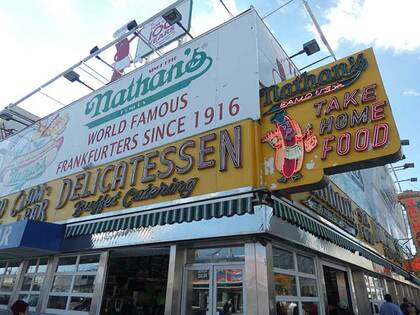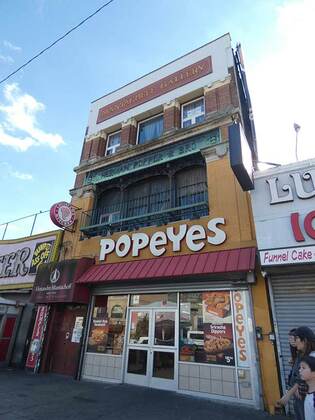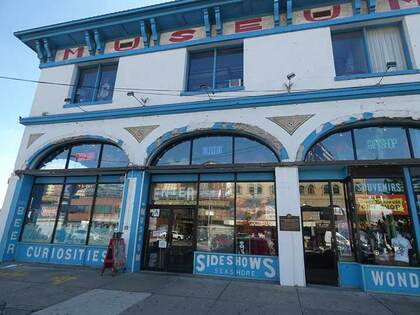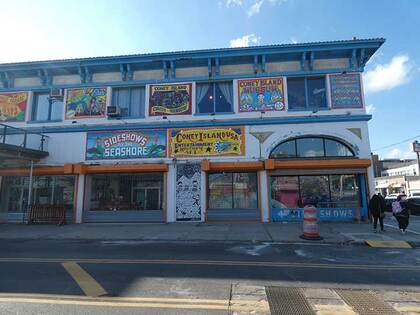What Brooklyn kid hasn’t been to Coney Island? I enjoyed the rides and all, but never ate a hot dog at Nathan’s Famous until 1999. I’ve never been a big roller coaster guy, and haven’t ridden the Cyclone or the Thunderbolt, but was coaxed onto the Wonder Wheel a few years ago. What I remember best as a boy were the bus trips. My father and/or mother and I would board a B64, which stopped three blocks away from our apartment at Fort Hamilton Parkway and 86th St.
The fare would be dropped in the box—it was only a couple of coins then—and the mechanized fare machine would make a rhythmic sound, and off we’d go past Dyker Park Golf Course, through Bath Beach and over the rickety, ramshackle Stillwell Avenue Bridge over Coney Island Creek (the bridge was replaced with a modern structure in the 1980s), finally coasting to a stop at Mermaid Ave. and Stillwell. In the 1960s, the Transit Authority was still, for the most part, featuring 1940s vintage GMC Model 1506 Buses, though by this time, the TA admitted defeat in their efforts to stop juvenile delinquents from cutting up the soft seats with switchblades, and so installed plastic seats. But the B64 line was different: that line featured the much boxier Mack, which swaggered down 86th St. and Bath Ave. on the way to Coney. I always preferred the B64 because we rode in style.
Even in the mid-1960s, Coney was past its prime, but still featured a lot more echoes of the old days than it does now. The Half Moon Hotel, Thunderbolt Roller Coaster, Playland amusement area, and the Catholic Youth Organization day camp on W. 26th St. were still there. One day when I was about five or six, my father and I were wandering down the western end of the boardwalk, with me eating an ear of corn, when we stopped by a boardwalk-side bar. My father wasn’t looking for a libation: he was a teetotaler. We were attracted by the sound. There, standing on a U-shaped bar, was a singing cowboy. The cowboy, I’ve later found out from Chales Denson’s excellent Coney Island Lost and Found, was likely Westy Fresco, and the bar was a club at the boardwalk and Stillwell Ave. known as the Atlantis; Westy was its drawing card until 1970, and the building now houses a boardwalk Nathan’s Famous.
Pictured is It’s Sugar, a candy store that’s held down the corner of Surf and Stillwell since 2012. Prior to that, there was a very old building housing a chicken franchise, Faber’s Fascination (where I spent hours on the pinball machines) and Shoot The Freak that was built in 1899 as a dance hall by Fred Henderson. The building was gutted in a 1903 fire, rebuilt, but then cut back in 1923 when Stillwell Ave. was widened. Until 1984 the building housed Lily Santangelo's House of Wax. It also featured almost up to its demolition around 2010 a flophouse called the Shore Hotel.

Nathan’s, also at Surf and Stillwell, is most famed for its frankfurters but at heart, it’s a seafood restaurant. Charles Feltman, the purported inventor of the hot dog, operated a food wagon in Coney Island beginning in 1867, and by 1874 the profits from his hot dogs enabled him to build his Ocean Pavilion enterprise. By 1946, when the restaurant finally closed, billions of frankfurters were sold.
In 1916 a Feltman’s employee, Nathan Handwerker, struck out on his own, renting a shack at Surf and Stillwell Aves. and sold hot dogs for a nickel. In the early years business was slow. Handwerker hit on the gimmick of dressing some local layabouts in white smocks, set them up behind the counter selling franks, and advertising his hot dogs approved by “doctors.” With the arrival of the BMT subway in 1920, his location proved advantageous and he was soon selling thousands, then millions, of hot dogs. Seafood items, including a clam bar and frog legs, were added to the menu and Nathan’s became the familiar institution it is today.
On my most recent visit to Nathan’s, I was disappointed because after I forked over my $25 for two franks, drink and fries, they came right away. That meant I was getting some food that had been laying around for a short time instead of fresh off the grill. The franks featured the usual snap casing that makes them special, but the fries, normally meaty mini-baked potatoes, were dry, and nothing was as hot as it could have been. Nathan’s has also eliminated in-store seating. A few years ago, my friend Joanna and I didn’t have Christmas plans and, as it was 65 degrees, off we went to Nathan’s. We got a parking spot right in front and sat down for a Christmas feast. One thing is still true. Nathan’s has some of the most exquisite neon signage in Brooklyn in its traditional colors of yellow, red and green.

Herman Popper and his brother built this building as a distillery and later, a tavern in 1904 on Surf Ave. near Stillwell. By 1999, it was assaulted by garish signage proclaiming the existence of a Carvel "ice cream bakery.”
By 1900, The Brooklyn Eagle lists Popper as owning “nearly all the land,” along with Frederick Henderson of Henderson’s Hall, on Henderson’s Walk between Surf Ave. and the Bowery. The article calls attention to the need for sewers in Coney Island and notes that Popper and Henderson were going to pave Henderson’s Walk, which was privately owned and not a public street, with asphalt rather than with the traditional Coney Island paving of wood planks.
Although a photo of Popper himself has yet to be found, it’s known that he was a large man, at least in width. He was a proud member of the Fat Men’s Association, a club in which all members were required to weigh at least 200 pounds (depending on height, that was “fat” in those days). As the treasurer of the group, his colleagues joked that he was “too fat to run away with the money.” By 2002, the Alexandre Mantacheff art gallery occupied the top floor. And Popeye’s Chicken, appropriate for the Popper Building, occupies most of it.


This building was originally constructed in 1917 in the Spanish Colonial Revival style for the Childs restaurant chain, a cafeteria-style restaurant founded in the 1880s in lower Manhattan which eventually grew to have over 100 locations in America and Canada. This building was the first of two Childs restaurants constructed in Coney Island; the other building on the Boardwalk was designated a landmark in 2003 and is now an entertainment center.
After its closure, the 1917 building became the home of a nightclub and restaurant known as the Blue Bird Casino. In the 1950s, the building changed uses again when it became David Rosen’s Wonderland Circus Sideshow, a legendary Coney Island attraction. The sideshow tradition continues in the building today with Coney Island USA’s Sideshow by the Seashore, a traditional 10-in-one circus sideshow. Coney Island USA operates many other favorites out of its building, including the Coney Island Museum, the Mermaid Parade, and other annual programs and events. For many years, Coney Island USA was just a renter of the former Childs Restaurant building, until a few years ago, with the City’s help, it purchased the building and made it its permanent home. Coney Island USA has since undertaken a restoration of its ground floor exterior and interior, revealing long-covered storefront arches and creating the Freak Bar.
Posters showing some of the Sideshow’s attractions are hanging on W. 12th St.

Shuttered for the winter is Eldorado Auto Skooter, which was hand-built by Joseph and Peter Buxbaum and Sandy Fitlin, and a carpenter named Rafael. The opening date was March 21st 1973, admission was 50 cents and 25-cent re-rides. The lighting is disco style from the Studio 54 era and the bumper cars are Italian made by Soli. The first record played was “Cisco Kid” by War.

Originally a theater featuring live shows and first-run movies on Surf and Stillwell Avenues, Loew's Theater, built in the 1920s, featured a Nedick’s on the ground floor and offices on the upper floors. It was once the second tallest building in Coney Island, next to the now-demolished Half Moon Hotel (see below). By the 1970s, Loew's, by then known as the Shore, was home to X-rated grindhouse films. Nedick’s gave way to a succession of businesses like the Gayway Bar and Grill and Kansas Fried Chicken; these days, not much is happening with the place. It has potential if Coney ever revives to where luxury housing is in demand: it’s at the center of the action. Currently, the building is scaffolded as it’s finally getting a rehabilitation.
For many years it was the tallest building in “downtown” Coney Island, with the exception of the high-rise projects that have sprung up along Surf Ave. and in Coney’s eastern and western sections.

Speaking of tall buildings, here’s the boardwalk end of the Seagate Rehabilitation and Nursing Center on the site of the old Half Moon Hotel, a 225-foot-tall, 14-story hotel that opened in 1927 on the Boardwalk at W. 29th Street. The Half Moon was built to help Coney Island compete with the beach resort Atlantic City, N.J. This was the place where mobster-turned-informant Abe Reles, who helped bring members of Murder, Inc. to justice, was either pushed or jumped out a window to his death on November 12, 1941, before he was scheduled to testify against Albert Anastasia. Though guarded by a six-officer police detail, his death was more or less assured. The name "Half Moon" refers to the name of 17th-century explorer Henry Hudson's ship, which anchored off Gravesend Bay in Brooklyn (the location of Coney Island), while searching for a short cut to Asia.
—Kevin Walsh is the webmaster of the award-winning website Forgotten NY, and the author of the books Forgotten New York (HarperCollins, 2006) and also, with the Greater Astoria Historical Society, Forgotten Queens (Arcadia, 2013)

